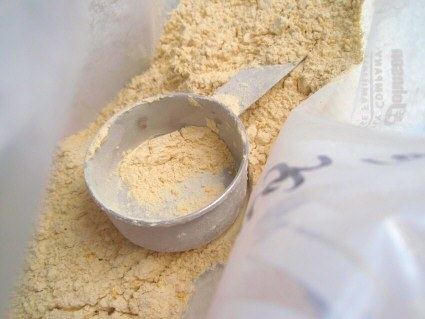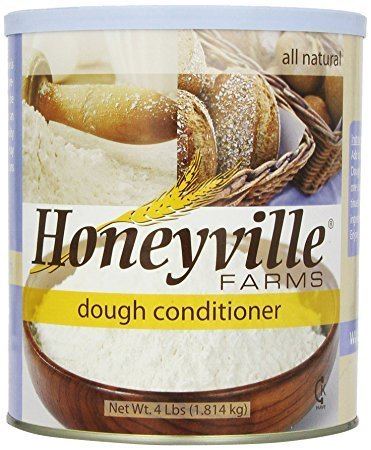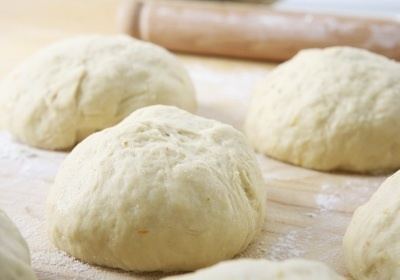Similar Flour, Water, Enriched flour, Flour bleaching agent, Barley malt | ||
A dough conditioner is any ingredient or chemical added to bread dough to strengthen its texture or otherwise improve it in some way. Dough conditioners may include enzymes, yeast nutrients, mineral salts, oxidants and reductants, and emulsifiers.
Contents
- That great subway bread smell it s dough conditioner azodicarbonamide
- Examples
- History
- Yeast nutrients
- Oxidants and reductants
- Emulsifiers
- References

That great subway bread smell it s dough conditioner azodicarbonamide
Examples

Examples of dough conditioners include ascorbic acid, distilled monoglycerides, citrate ester of monoglycerides, diglycerides, ammonium chloride, enzymes, diacetyl tartaric acid ester of monoglycerides or DATEM, potassium bromate, calcium salts such as calcium iodate, L-cystine, azodicarbonamide, sodium stearoyl lactylate, sucrose palmitate or sucrose ester, polyoxyethylene sorbitan monostearate or polysorbate, soybean lecithin, and soybean lecithin enriched with lysophospholipids.

Less processed dough conditioners include sprouted- or malted-grain flours, soy, milk, wheat germ, potatoes, gluten, yeast, and extra kneading. Malted, diastatic flours are not typically added by manufacturers to whole-wheat flours. Robertson et al. point out that some of the better information is found in baking books published back when bakers were still kneading by hand.
History

In the early 1900s it was discovered the use of calcium chlorid [sic], ammonium sulfate, and potassium bromate halved the amount of yeast needed to raise dough. These mixtures were generally known as mineral yeast foods or yeast nutrient salts. After they became popular among bakers, one patented yeast food was analyzed by Connecticut Agricultural Experiment Station chief chemist J.P. Street who published in 1917 that it contained, "calcium sulphate, 25; ammonium chlorid, 9.7; potassium bromate, 0.3; sodium chlorid, 25; patent wheat flour, 40." They contain water conditioners, yeast conditioners, and dough conditioners.
Yeast nutrients

Yeast requires water, carbon sources such as starch and simple carbohydrates, nitrogen preferably as ammonium as it cannot assimilate nitrate, sulfur, phosphorus (often as inorganic phosphate), and minute quantities of vitamins and elemental mineral ions including B, Ca, Co, Cu, Fe, K, Mo, Mn, Mg, Ni, and Zn. Ammonium chloride, ammonium sulfate, or ammonium phosphate may be used as sources of nitrogen. Phosphoric acid, an acidulant, is used as a yeast stimulant. Calcium iodate, an oxidant, is a U.S. Food and Drug Administration generally recognized as safe or GRAS source of calcium.
Oxidants and reductants

Dehydroascorbic acid and potassium bromate are oxidants, acting on sulfhydryl groups and disulfide bonds in wheat dough, in particular oxidizing glutathione. Potassium bromate acts more directly or with fewer chemical conversion steps than ascorbic acid. Glutathione increases wheat dough's extensibility, or relaxes it, while oxidizing a dough's glutathione increases elasticity. Like glutathione, cysteine and bisulfite are reducing agents which relax wheat dough. Adding minute amounts of oxidants or reducing agents alter the post-mix handling characteristics of dough.
Emulsifiers
Lecithin, monoglycerides, diglycerides, and DATEM are considered emulsifiers. They disperse fat more evenly throughout the dough, helping it to trap more of the CO2 produced by yeast. Lecithin added at a rate of 0.25-to-0.6% of the flour weight acts as a dough conditioner. Based on total weight, egg yolk contains about 9% lecithin. Monoglycerides and diglycerides replace eggs in baked goods. Emulsifiers tend to produce a finer grain, softer crumb, and with longer proof times, increased baked volume.
